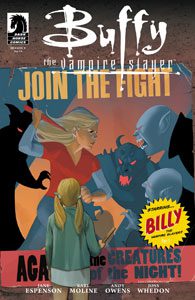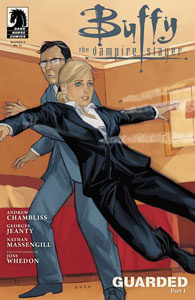In this next batch of 10 issues, Season 9 becomes slightly less Buffy-centric, somewhat to its detriment, but Andrew Chambliss continues to be a sharp writer and I trust he knows where the wider narrative is going. The only major misstep in this batch, surprisingly, is when “Buffy” veterans Jane Espenson and Drew Z. Greenberg step in for two issues to tell the origin story of side character Billy.
“Guarded” (Issues 11-13, July-September 2012)
“Guarded” features none of the Scooby Gang besides Buffy, but I don’t feel like I’m missing much. That’s not to say I don’t want to catch up with Willow, Spike, Xander and Dawn eventually (especially the latter two – what’s up with their feud?). But it’s a testament to this comic’s world-building and Chambliss’ focus on Buffy that a three-issue arc can be compelling without the usual supporting cast.
Trying her hand at a profession, Buffy embarks on training and then her first mission with Deepscan, a bodyguard service led by Kennedy that employs many Slayers. On paper, it’s perfect for Buffy; in practice, it’s not. Her Slayer instincts aren’t honed toward corporate espionage. Amusingly, she attacks an innocent demon while a “cleaning lady” goes after the suit Buffy is supposed to protect – luckily, it’s a training exercise.
Issues 12-13 chronicle an assignment to protect a web developer named Theo from Wolfram & Hart. While the Seed’s destruction has closed off dimensional portals, Theo’s Tin Can website (think Facebook for demons) links to the dimension where W&H’s senior partners are stuck. Destroy Tin Can, and the evil law firm is cut off from Earth.
Lots of zesty character points come to a head as Buffy struggles between protecting Theo (which the job and her Slayer duties entail) and saving the world (which her Slayer duties also entail). Another wrinkle to consider is that having a digital connection to other dimensions might not be an intrinsically bad thing.
It’s nice to see Kennedy and Buffy working together to fight a tentacled demon that fills a whole building (!), even if their philosophies clash. Kennedy is initially annoying on the TV show because she infiltrates our familiar friends and has an attitude, but Chambliss has found a perfect supporting role for her (and really, Kennedy isn’t that bad on repeat viewings of Season 7).
This is another story where Buffy affirms to herself that she’s the Slayer above all else, for better or worse. But it’s a notch deeper than most, since we see that even in a job that takes advantage of her physical skills, her Slayerness gets in the way.
“Guarded” also dials up an intriguing mystery: W&H tells Koh that the mysterious enemy who had imprisoned him is located on Earth. That’s a small clue in and of itself, but peeking ahead, I see Illyria is on some upcoming covers …
4 stars

“Billy the Vampire Slayer” (Issues 14-15, October-November 2012)
This two-parter is difficult to criticize. Since “Billy the Vampire Slayer” adds a gay male character to the “Buffy” pantheon, it automatically has political undertones, and it’s certainly not a bad idea on the face of it. My problem is that this is an extremely basic story about a teenager choosing to fight the good fight and finding his first love, his “Watcher” Devon.

This is surprising considering that it’s written by “Buffy” TV veterans Espenson and Greenberg, who usually don’t write yarns where I know exactly where it’s going and can quickly flip through to the end. I guess it’s like my friend Michael said about the movie “Love, Simon”: It’s noteworthy because it’s a mediocre gay rom-com, rather than a statement-making gay movie. Likewise, Billy has his share of fans because he’s a gay “Buffy” hero with an unremarkable origin story. At least they don’t re-imagine one of the established straight characters as being gay this time.
2.5 stars

“Welcome to the Team” (Issues 16-19, December 2012-March 2013)
After his two-issue handoff, a refreshed Chambliss delivers the excellent four-parter “Welcome to the Team.” The most obvious hook is the return of Illyria, as featured on most of the cover art – not because she is Koh’s ancient enemy (that mystery continues to boil), but rather because she’s among a “Council” of demons (including D’Hoffryn) that aims to stop Severin. She’s more in the selfish mode of old-school Illyria than the reformed version from the end of IDW’s “Angel.” Chambliss addresses this in Illyria’s dialog to Buffy, who had heard from Angel and Spike about Illyria’s newfound humanity: “I was not like their beloved Fred. It was an affectation to please them.” It’s a retcon, but at least Chambliss doesn’t ignore IDW’s work, so I’ll allow it.
As the tale moves forward though, the most memorable part is Dawn’s sickness. At first it seems like the flu – and colorist Michelle Madsen does a wonderful job illustrating this via Dawn’s reddened nose. But it’s actually the Key flu, for lack of a better term: Because Dawn comes from magic, her body is shutting down now that the Seed has been destroyed. I like how Andrew tries to move Dawn’s mind into the Buffy-bot, and while I’m OK with that not working, it could’ve been highly entertaining to have Dawn in a Buffy body for an issue or two.
Because Xander has been grumpy this whole season, I buy it when he snaps at Buffy at the end of Issue 19, blaming her for Dawn’s sickness. While the lack of domestic bliss isn’t bluntly explained, I gather that Xander is insecure with having abandoned the Scooby Gang to try to keep Dawn safe. Choosing between two women he loves makes him resent the one he does choose. And when Dawn ends up in danger anyway, he shifts his resentment to Buffy.
In a nice twist, Buffy’s roommate Anaheed was a Slayer all along. She was serving as a protector for Buffy, but seeing Billy in action, she now trusts him. Anaheed’s character-building via a panel here, a panel there, works better than Billy’s backstory being dumped into two issues.
In the bigger narrative scope, Severin is back in play, and the reason he’s targeting Illyria is he suspects his powers might be like those of Rogue in “X-Men”: Not only does he drain someone’s life-force, he also gains their specific powers, and one of Illyria’s powers is time travel. He wants to go back in time to save his girlfriend who had been turned into a zompire.
But even draining Illyria completely – so she looks like Fred now, but she isn’t – Severin isn’t powerful enough to travel long distances back in time. Meanwhile, Simone is doing some creepy experimenting too – siccing zompires on Slayers to see if a Slayer-zompire could retain its sanity while gaining the super-strength. That plan isn’t working either. But Severin and Simone are firmly established as worthy Big Bads for Season 9.
4.5 stars

“The Watcher” (Issue 20, April 2013)
This Xander-centric one-shot is an effective but sparse bridge to the five-issue season finale. We get insight into Xander’s feelings: He hates that he has watched helplessly as Joyce, Tara, Anya, Renee and Giles have died. He thinks he’s a lowercase-W watcher, and he can’t live with seeing Dawn become the latest casualty. His feud with Buffy is amusingly (if darkly) illustrated by the fact that they don’t say anything to each other, using Andrew as a go-between despite being in the same room.
In the flatter back half of the issue, Simone and Severin – after teleporting Xander to their HQ via the power he siphoned from Illyria – ask for Xander’s help. They need him to grab Buffy’s “Vampyre” book for them. That Xander is interested in any way to help Dawn isn’t surprising; that he’d say “I’m in” without asking the specifics of their plan is frustrating. Willow is back from “Willow: Wonderland,” and she has limited access to magic again, so maybe she can save Dawn. I hope this doesn’t become one of those plots that creates conflict from people not communicating, like when Wesley steals Connor in “Angel” Season 3.
3.5 stars
Click here for an index of all of John’s “Buffy” and “Angel” reviews.

